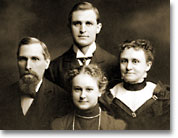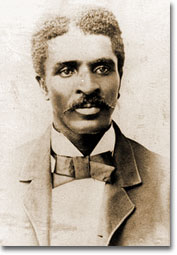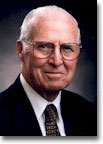by Tom Morain
The story begins in the Farm House on the campus of Iowa State University in Ames. Shortly after the Civil War, Professor Joseph Budd and his family moved into the Farm House. Joseph Budd was a professor of horticulture at Iowa State. He had a daughter named Etta May.
After studying art in the East, Etta Budd returned to the Midwest to teach art at Simpson College in Indianola. There she met a young black man, the son of former slaves. He was enrolled in one of her art classes. He loved to paint, especially still life paintings of plants and flowers. He was also a good gardener. Etta Budd helped him find gardening jobs with families around Indianola. The young man's name was George Washington Carver.
 As his friend and art teacher, Etta Budd took Carver aside one day and urged him to study something besides art. Etta told him he could never support himself or a family with his artwork. Instead of painting plants, she encouraged him to study them. She offered to go with him to Iowa State where her father was a professor. After thinking about it, Carver agreed to enroll at Iowa State.
As his friend and art teacher, Etta Budd took Carver aside one day and urged him to study something besides art. Etta told him he could never support himself or a family with his artwork. Instead of painting plants, she encouraged him to study them. She offered to go with him to Iowa State where her father was a professor. After thinking about it, Carver agreed to enroll at Iowa State.
Some time later, Etta visited George Washington Carver at Ames. There she discovered something that made her very unhappy. Because Carver was black he had to eat his meals in the kitchen rather than the dining hall with the other students. This was unacceptable to Etta. She brought him into the dining hall where the white students took their meals. There she ate with him until the other students accepted him.
At Iowa State Carver was a brilliant biology student. He even took graduate work and upon graduation, was offered a teaching position. He was the first black teacher that Iowa State had ever hired.
While at Iowa State, Carver used to take long walks into the surrounding fields to study plants for research. On some of these walks he took a little friend with him. His friend was the six-year-old son of a dairy science professor. Carver shared his love of plants, and the boy responded enthusiastically. At the age of eleven, that boy began doing experiments with different varieties of corn. His name was Henry A. Wallace.
 As an adult, Wallace's fascination with corn continued. He developed some of the first hybrid corn varieties and even published his findings in Wallaces' Farmer Magazine. He also founded Pioneer Hi-bred International, Inc. By planting his hybrid seed, the per acre yields of Midwestern corn doubled and tripled.
As an adult, Wallace's fascination with corn continued. He developed some of the first hybrid corn varieties and even published his findings in Wallaces' Farmer Magazine. He also founded Pioneer Hi-bred International, Inc. By planting his hybrid seed, the per acre yields of Midwestern corn doubled and tripled.
In 1933, Wallace became Secretary of Agriculture under President Franklin Roosevelt. Then in 1940 he became Vice President under Roosevelt.

After the election of 1940, Wallace took a vacation trip to Mexico. There he found corn to be an important part of most Mexican families' diet. But the yield in Mexico was so much lower than that of American farmers who planted hybrid corn varieties.
Wallace had an idea. He would create agriculture experimental stations like those in Iowa. The stations would develop improved corn varieties adapted for the climate and soil of Mexico. On his return to the United States, he proposed the idea to the Rockefeller Foundation. The Foundation welcomed the idea, and an experimental station was built in Mexico.
One of the first scientists to join the station started by Wallace in Mexico was Norman Borlaug. Born and raised in Cresco, Iowa, Borlaug's work led to great increases in agricultural production in Mexico.
Twenty years after the station was built,  corn production in Mexico had doubled, and wheat production had increased five-fold. Borlaug went on to win the 1970 Nobel Peace Prize for his development of high-yielding wheat.
corn production in Mexico had doubled, and wheat production had increased five-fold. Borlaug went on to win the 1970 Nobel Peace Prize for his development of high-yielding wheat.
The work of Borlaug and others in expanding yields of corn, wheat, and rice prevented worldwide famine. Over the years, the lives of a billion people were saved.
No one asked Etta Budd to feed a billion people. Her task as she saw it, was to end a stupid and degrading practice that demeaned her friend, George Washington Carver. In doing so, however, she set in motion a series of relationships that changed the world.
Etta Budd helped Carver…Carver helped Wallace…Wallace helped Borlaug…Borlaug helped the world…
| "Do not forget that the value and interest of life is not so much to do conspicuous things as to do ordinary things with the perception of their enormous value." ~Teilhard de Chardin |
Photos used with permission from:
Iowa State University Library/Special Collections - Etta May Budd photo
New Deal Network - Henry A. Wallace photo
Iowa State University Library/Special Collections - George Washington Carver photo
Gary Thelen - Henry A.Wallace Gravestone photo
The World Food Prize Foundation - Norman Borlaug photo

Copyright © 2022 CampSilos | All Rights Reserved
National Standards | Silos & Smokestacks | Credits | Awards
Crafted by IFC Studios, a midwest Branding Agency.